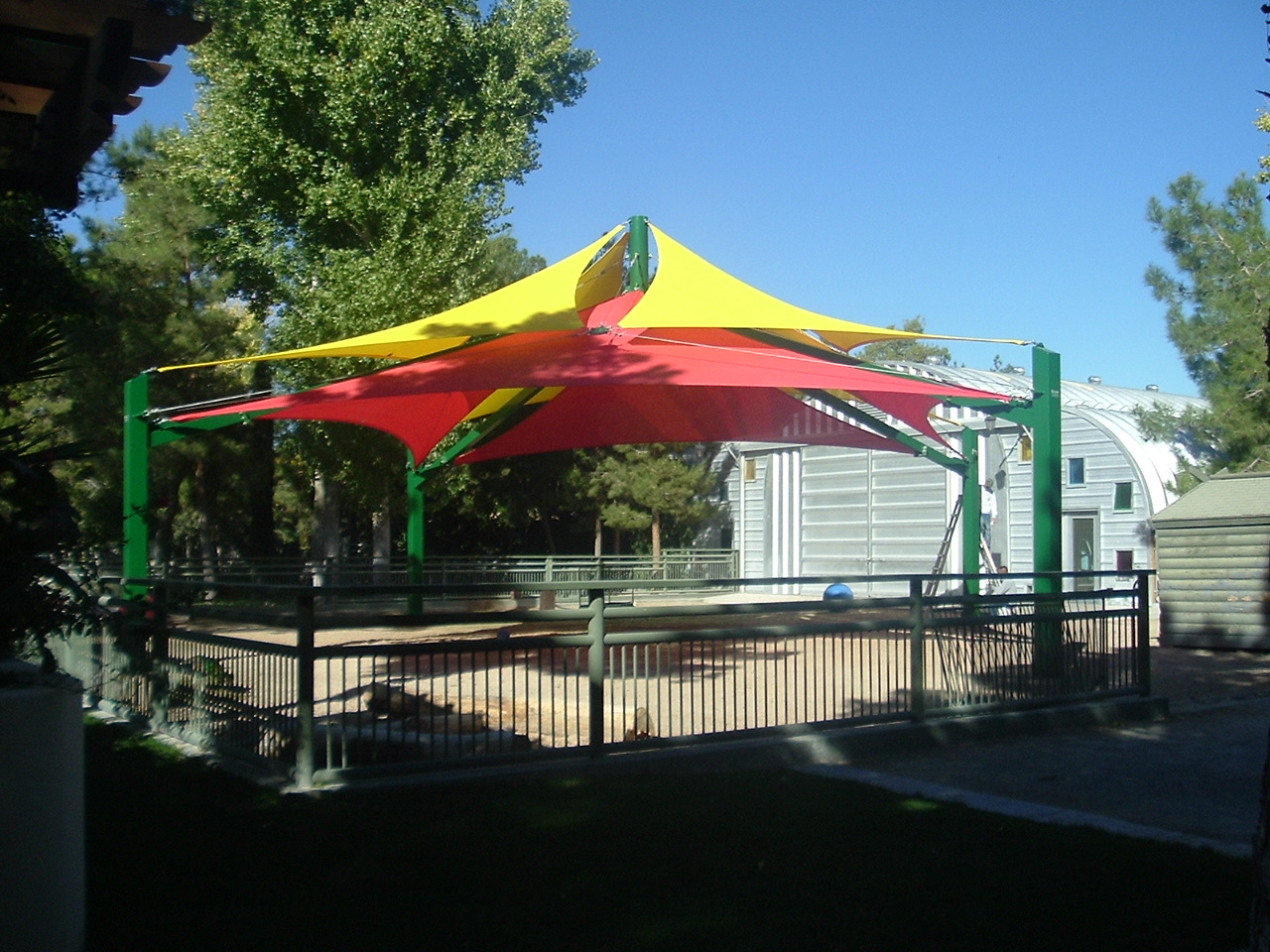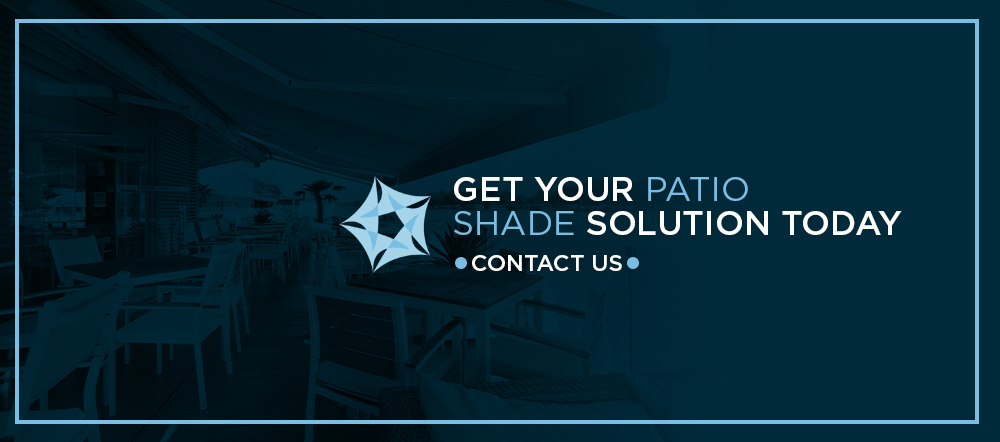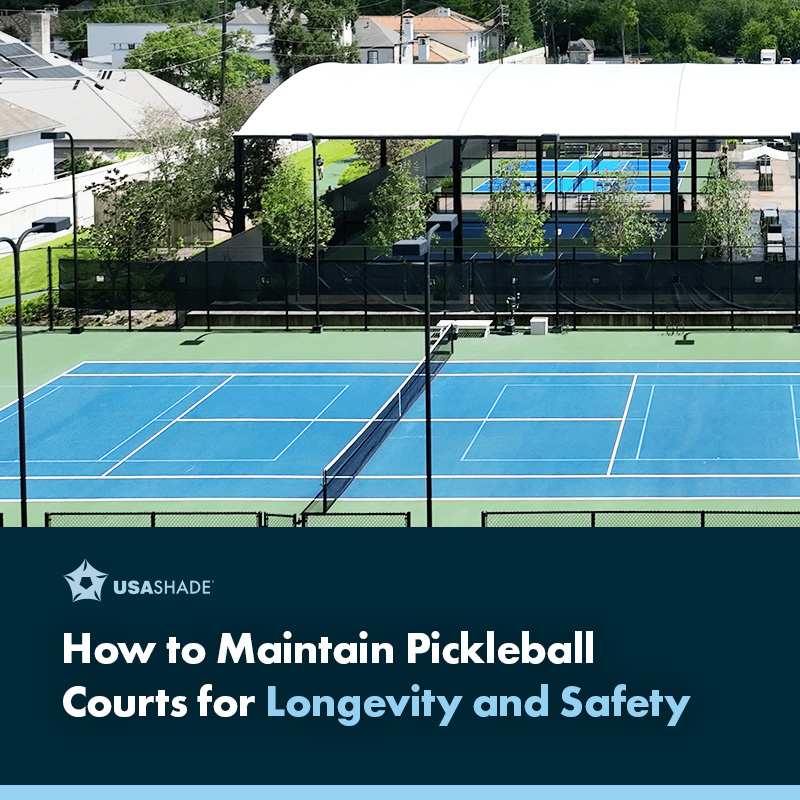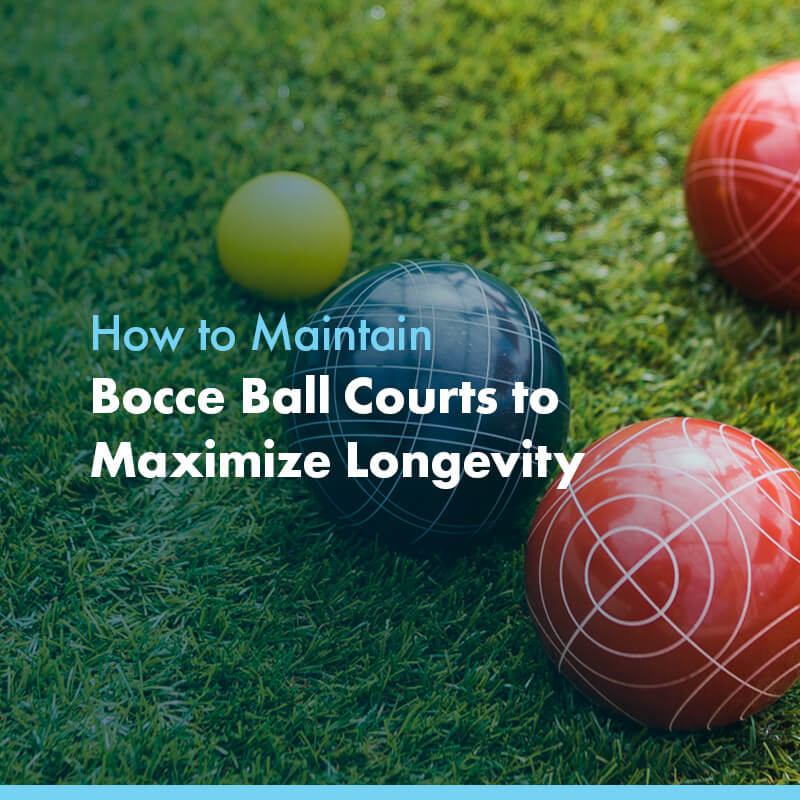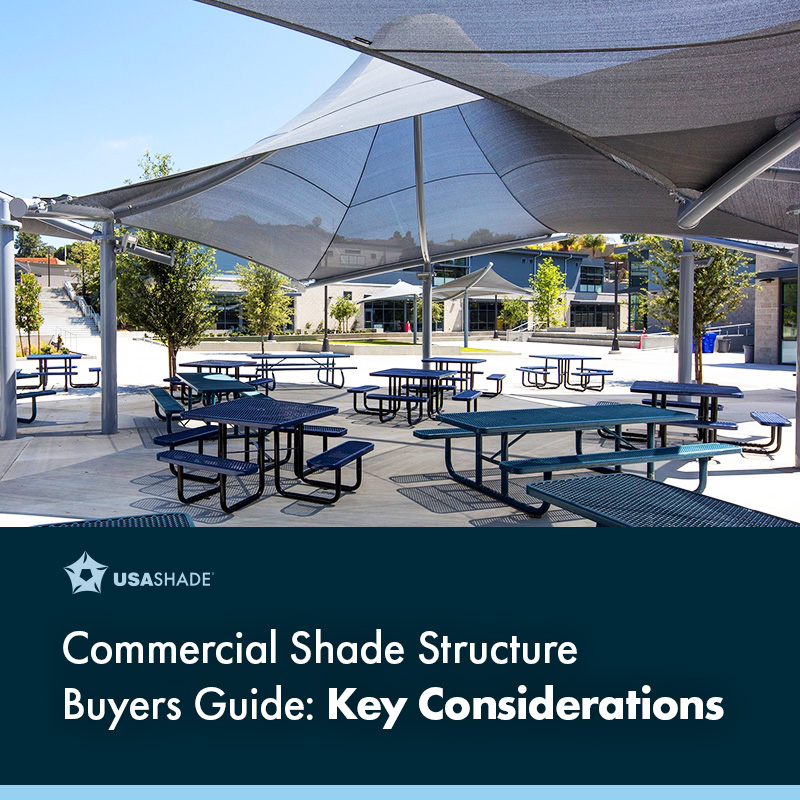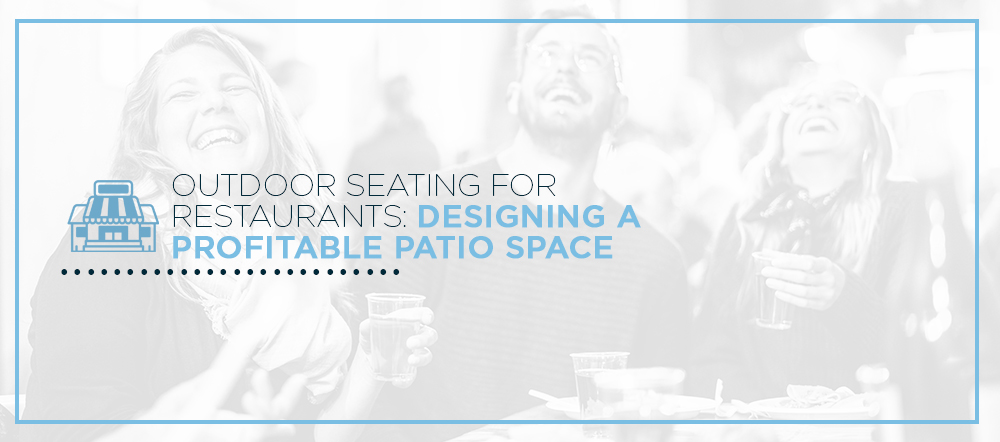
Whether you’re running a small cafe, a quick-serve restaurant, or a full-service restaurant, you’re always looking for ways to improve the customer experience and yield greater profits. Some of the most important components to get right are large factors such as food quality, customer service, and meal price.
But once you’ve found the right balance of all those things, it’s time to start looking for other ways to improve the quality of your establishment. Though your first instinct might be to search the inside of your restaurant for areas to improve, you may want to consider shifting your attention to the outside instead. When done right, one of the best assets a restaurant can have is an outdoor seating area.
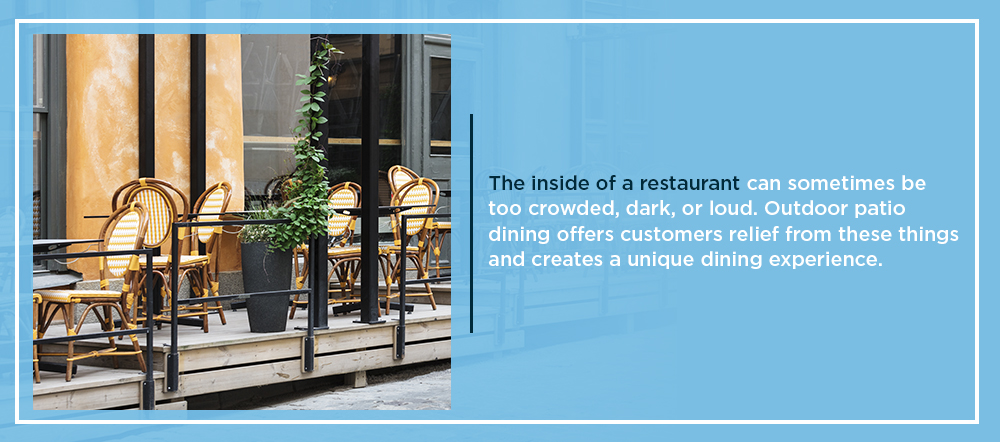
Why Have a Restaurant Patio?
There are many benefits to outdoor restaurant seating, and a patio with additional seating can do a lot to entice customers into dining with your restaurant.
The inside of a restaurant can sometimes be too crowded, dark, or loud. Outdoor patio dining offers customers relief from these things and creates a unique dining experience. While sitting outside, customers can breathe fresh air. Tables can spread out more, making it less crowded, and the open-air environment alleviates loud reverberations that could happen inside of a noisy establishment. In the daytime, there’s plenty of natural light.
The result is that you can improve the customer dining experience by having an alternative seating area for guests with different preferences, many of whom may return to take advantage of the ideal dining environment your patio provides. In fact, not offering outdoor seating options can cause you to lose customers to competitor restaurants that do.
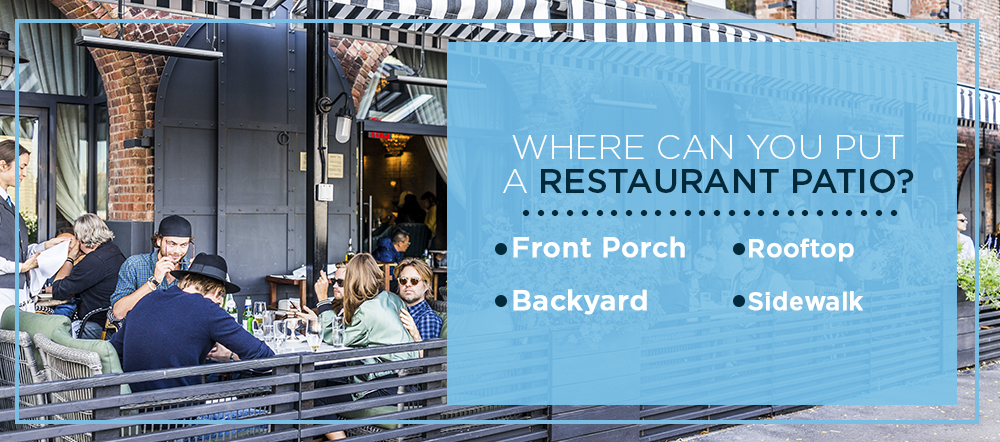
Where Can You Put a Restaurant Patio?
Not all patios are located in the same area of the restaurant. To find an effective restaurant patio design, you have to assess what will work best for your business. Is your restaurant surrounded by plenty of open space, or bookended between two other buildings? Does it overlook a hillside view, or face brick walls and streets on all sides?
Depending on your circumstances, you could end up with a few different choices. Likely your options will each fall into one of four categories — front porch, backyard, rooftop, or sidewalk.
1. Front Porch
Front porch patios are normally located at or near the main entrance of a restaurant. It is not uncommon for patrons to walk past or even through them to get inside the establishment. This arrangement guarantees that everyone visiting the restaurant will see the front porch patio on their way in, enticing many to sit in this area.
This type of patio location can be found at many building types, from rural roadhouse to an urban cafe. Offering just two or three tables out front can often do the job.
2. Backyard
Backyard patios aren’t always located in the typical residential backyard, but they can have the same effect. They can be often be found behind a restaurant or in a side yard. More importantly, patrons must walk through the interior of the restaurant to reach them. In many ways, these areas can have the opposite effect of front porch patios.
Front porch patios are open to passers-by and onlookers, virtually eliminating any dining privacy. Backyard patios often carry an air of exclusivity. By the very fact they may not be openly “advertised”, they garner interest from everyone who learns of them. As word spreads, patrons will want to gain access to the much-discussed patio and become drawn to the restaurant as a result.
3. Rooftop
Rooftop patios are commonly found in urban areas where space is very limited for seating. This often leaves the rooftop as an ideal space for dining. In addition to the open-air ambiance, rooftop dining also offers the allure of spectacular views of the local skyline while enjoying a meal.
4. Sidewalk
Similar to front porch patios, sidewalk or “bistro-style” seating is often located at or near the main entrance. The distinguishing feature of sidewalk seating is the close proximity to passers-by. Because of this seating arrangement, restaurants have an instant visual marketing tool to entice new patrons that may not have considered the establishment before.
Even if they don’t immediately get pulled in, people will often remember the seating arrangement, particularly if they frequent the area. Eventually, that memory can resurface when they’re looking for a place to eat, which can serve as the deciding factor in choosing your restaurant.
Tips & Ideas for Designing Outdoor Seating at Restaurants
Deciding where your patio should be located is a good start, but you’ll also need to consider other factors when designing an outdoor dining area. From government regulations to furniture arrangement, there are many variables to consider as you design the layout of your patio.
Of course, there’s no one answer for building an outdoor seating area for a restaurant, but there are options you can consider incorporating into the space. Here are some restaurant outdoor dining patio design considerations to be aware of.
1. Ensure Level Ground
This can be an easy thing to overlook, but uneven ground can cause a myriad of problems, not least of which is the safety of your patrons and employees. Spaces that have a more naturalistic floor, rather than something like concrete, will require a more deliberate approach. If you don’t get this right, you will end up with unstable tables and chairs, in addition to a variety of possible tripping hazards.
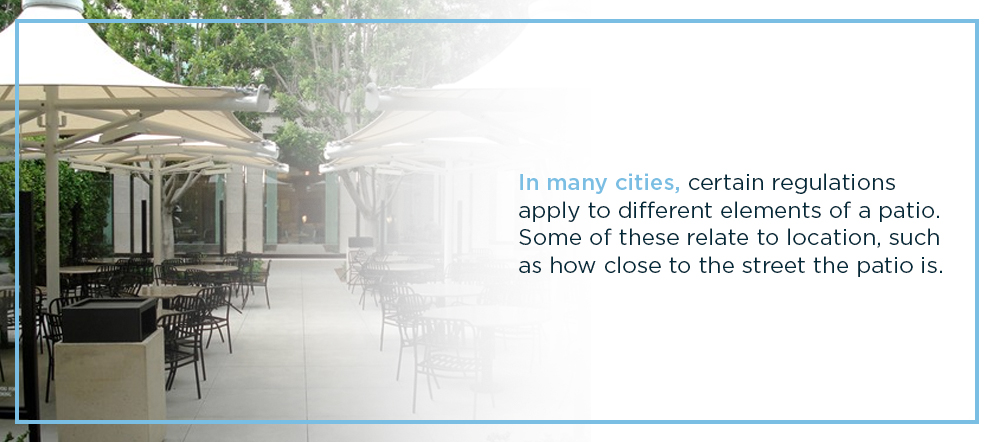
2. Understand Relevant Laws
In many cities, certain regulations apply to different elements of a patio. Some of these relate to location, such as how close to the street the patio is situated. Others involve health concerns— if you want to let customers smoke or bring their dogs into the patio, you’ll often need to apply for a permit for these. This isn’t normally a difficult process but violating these types of laws is not a good way to start.
3. Use the View
Before you decide on the location of your patio, consider the surroundings. Is there a particular side of the restaurant that’s more visually appealing? Is there a nice view nearby, perhaps of a beach or city skyline? Likewise, is there any side of the restaurant that should be avoided or faces something off-putting?
Let the answers to these types of questions guide your decision process. Perhaps you’re considering using sidewalk seating, but the lot across the street has been under never-ending construction. Your customers won’t want to sit somewhere that doesn’t provide for a comfortable dining experience.
4. Separate From Crowds
Much of a patio’s appeal comes from the fact that it’s open-air, away from the close quarters of a restaurant’s interior. But if the patio is just as crowded as inside, that appeal can be lost. While it can be tempting to fit as many tables into the patio as possible to maximize the number of patrons, overcrowding the space can negatively affect customers, employees, and your restaurant.
When you are deciding on the placement of your patio, you may want to consider somewhere away from the bustle of the restaurant’s interior. Likewise, if it’s street-side, consider placing some form of barrier between the seating and street. Within the patio itself, limit the number of tables so you have room to space them appropriately.
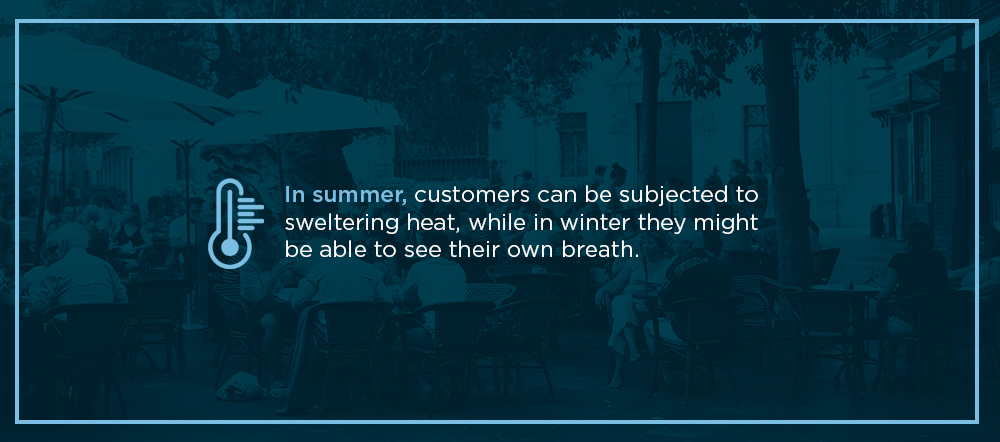
5. Regulate Temperature
One of the disadvantages of outdoor seating is exposure to the elements. In the summer, customers can be subjected to sweltering heat, while in winter, bone-chilling cold isn’t the best atmosphere for a comfortable meal. To some extent, you can expect a decreased interest in patio seating during times of extreme temperatures. But even for outdoor seating, you can still take steps to help regulate ambient temperatures.
Installing fans and cooling systems for the summer months and space heaters for the winter can have a significant impact on the comfort level of your patio. Without the insulation of enclosed walls, such systems won’t be able to function as efficiently as their indoor equivalents, but that doesn’t mean they can’t have an impact. Fabric shade structures can also dramatically reduce ambient temperatures during the hot summer months.
6. Guard Against Pests
Even indoors, restaurants have to be on constant alert for pests attracted to the ample supply of food. Outside, without even the most basic protection of walls and doors, this job becomes even more important. Good pest prevention in patios requires a mixture of the right products and practices.
You can start by installing fly traps and bug zappers around the area to minimize the number of insects. Past that point, the best thing you can do is to be diligent about keeping the area clean. Leaving food on the dining tables or ground is sure to attract bugs and small animals.
7. Consider Furniture Material
Tables and chairs come in many different options, but which type is best for your restaurant? Ultimately, it will depend on your priorities. You’ll have three primary materials to choose from, each of which comes with its own advantages:
- Wood: Wood has a great, natural appearance and often complements the aesthetic of outdoor seating.
- Metal: Metal is incredibly durable, minimizing the need for early replacement.
- Plastic: Plastic is lightweight, highly resistant to weather, and can be easily customized.
To decide which material is right for you space, assess factors like budget, your brand and the weather patterns in your area. Then select the material that’s best suited to those elements.
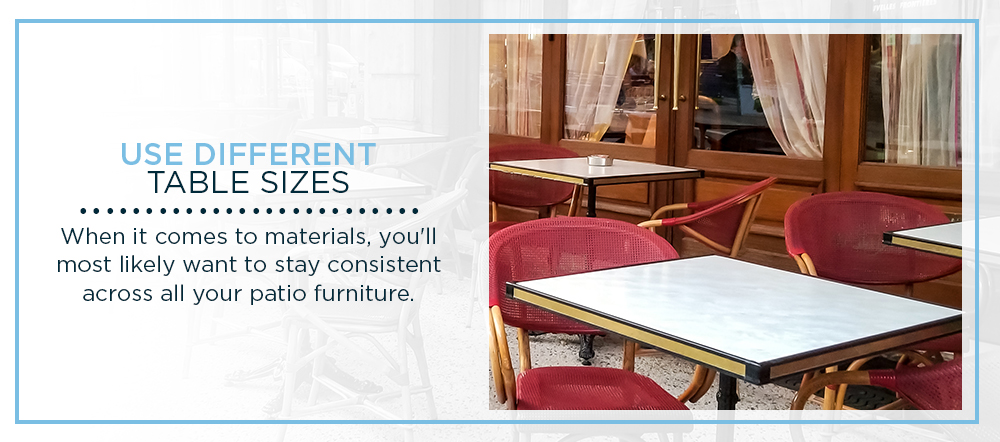
8. Use Different Table Sizes
When it comes to materials, you’ll most likely want to stay consistent across all your patio furniture. But size is a different story. It’s to your advantage to place a mixture of small and large tables in your patio, as this will attract parties of varying sizes. Whether it’s a pair of friends getting together for lunch or a family dining out for the evening, the patio will be an appealing space for your restaurant.
9. Have an Evacuation Plan
Though you’ll hopefully never need it, you still want to have an evacuation plan in place. Sometimes dangerous events like fires can occur and you want to keep your customers and employees safe.
For front porch patios, this may not be quite as concerning, since it’s already right at the entrance. But if your restaurant has a backyard or rooftop patio, you won’t want to risk having anyone trapped there. A carefully designed evacuation plan will ensure a safe escape for anyone there, should that ever be needed.
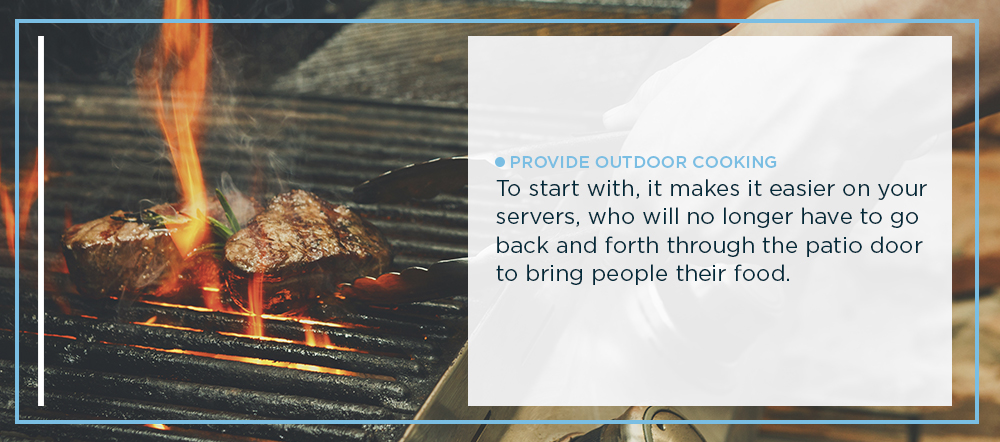
10. Provide Outdoor Cooking Areas
Outdoor cooking offers two main benefits. To start with, it makes it easier on your servers, who will no longer have to go back and forth through the patio door to service customers. This arrangement minimizes the chances of them dropping food and enables customers to get their meals more quickly.
The other benefit is that it allows for food transparency. Customers will get to see their food cooked right in front of them so they know exactly how it’s prepared. This will increase trust and encourage repeat business.
11. Install an Outdoor Bar
If your restaurant serves alcohol, you may want to think about building an outdoor bar. Any customers who visit to meet for drinks may also want to enjoy your patio, but if your only bar is inside, they won’t have the option of outdoor seating.
Designing a bar on the patio means they can sit at the bar as usual, but in an outdoor setting. This arrangement will add yet another group of customers to the ranks of people drawn to your restaurant.
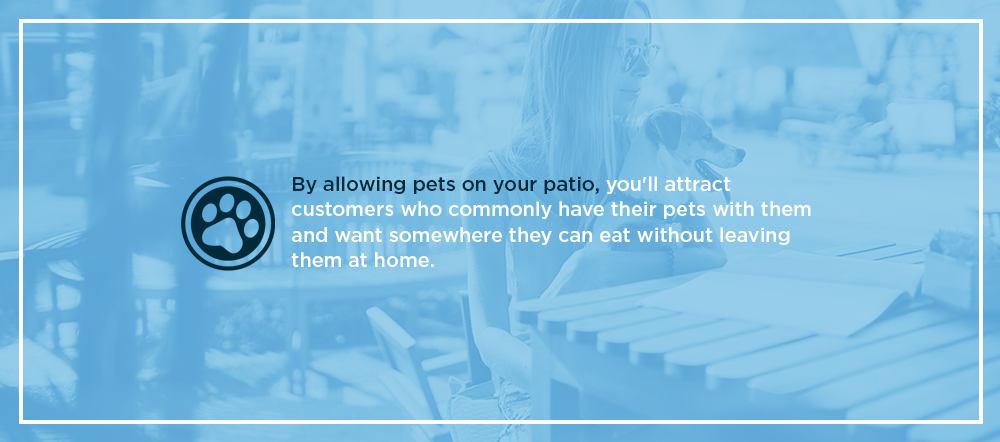
12. Make It Pet-Friendly
Another appeal of patios is that they frequently allow people to bring their pets with them. Health concerns — and subsequent legal ramifications — typically prevent pets from being allowed into restaurant interiors, but patios provide an outdoor space that better provides for visits from man’s best friend.
By allowing pets on your patio, you’ll attract customers who commonly take their pets with them and want somewhere they can eat without leaving them at home. Just make sure you’re familiar with any relevant regulations beforehand.
13. Install a Bicycle Rack
Just as some people seek out a restaurant that will give them a space for their pets, others rely on a bicycle as their primary means of transportation and want to eat somewhere close to a bike rack. If your restaurant is located in a rural area, this may not be as much of a concern.
But if you’re in a city where people commonly rely on bicycles to get around, you may want to install a bike rack near your patio. It’s a simple thing, but it gives people a place they can eat while keeping an eye on their transportation.
14. Play Music
Most restaurants play music indoors as a way of creating a more relaxing atmosphere for customers. Sometimes it’s louder, other times quieter, but it always helps set the mood of the restaurant. But restaurants often forget to extend this feature to the outside of their establishment.
Of course, you don’t want to play your music outside at a high volume. But at appropriate volume levels, music can add another facet to your patio’s atmosphere. Install outdoor speakers that connect to your sound system so all of your customers will be treated to the same musical experience, whether indoors or outdoors.
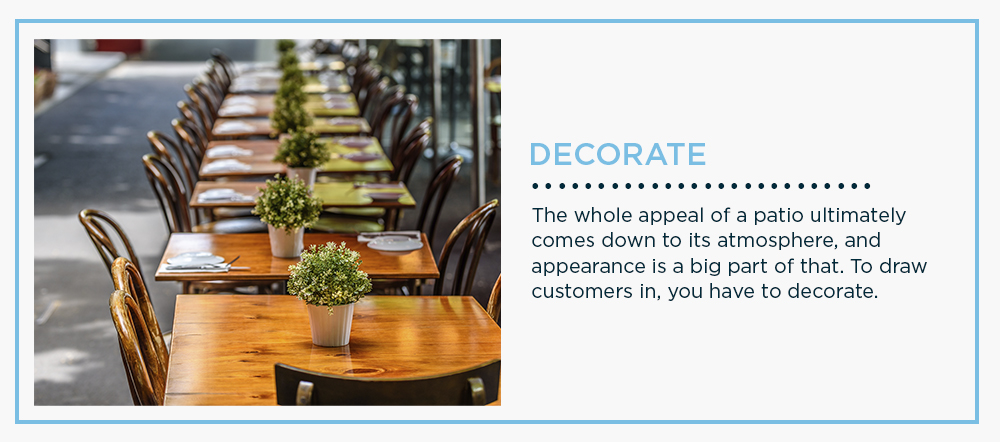
15. Decorate
The whole appeal of a patio ultimately comes down to its atmosphere, and appearance is a big part of that. To draw customers in, your decorations can play a big part! How you decorate is up to you, but consider the type of decor most suitable for the type of restaurant you have. Cafes, casual eateries and fine dining each call for different decorations. Here are some basic outdoor restaurant decor ideas for each of those three categories.
- Cafes: The atmosphere of a cafe should be light, so you can keep the decorations on the subtle side. Think about distributing plants around the patio, and rely on small things like the furniture design to define the feeling of the space.
- Casual dining: Casual dining decor can vary significantly, but a good rule of thumb is to continue the theme of the restaurant’s interior out to the patio. This process can involve using similar patterns, color schemes and furniture when you can.
- Fine dining: Fine dining is where you can go big. You don’t have to, of course. But if you want to put in a fountain, a firepit or something along that scale, fine dining restaurants can be a great place to do it. Additionally, consider that most customers enjoy fine dining at night, so invest in decorative, attractive lighting. You can find many ideas for outdoor restaurant patios online, ranging from fairy lights to candles.
16. Incorporate Shade
Eating outdoors provides customers with fresh air, natural light and greater personal space. Unfortunately, there can be downsides to being outside as well. Without the enclosure of a building around them, customers are subjected to the natural elements, whatever they may be.
Some days your patio will bake in the sun, while other days it may be drenched with rain. Customers won’t be eager to eat outside in either of those circumstances. In the case of rain, it’s not just the customers you have to worry about — any furniture cushions or equipment you may have outside could get ruined. And even when the rain’s gone, no one will want to sit on wet chairs.
Any easy and practical solution to these issues is to incorporate some outdoor seating shade structures to your space. For small patios with only a few tables, you can rely on umbrella covers. For larger patios, however, these may not offer much protection. In that case, the best option is to install a canopy to cover the entire patio area. Beneath it, customers can enjoy the open-air restaurant design without suffering the effects of heat and the sun’s UV rays. A shade solution can also improve the aesthetic appeal of your patio.
Get Your Restaurant Patio Shade Solution Today
If you’re looking at developing a patio for your restaurant, consider including a shade structure. A shade structure can help your patio generate higher revenue from customers and protect you from replacement costs associated with items damaged by the sun or rain. It’s clear that shade structures are an effective solution for patio dining, but where can you get yours?
Look no further than USA SHADE. We offer high-quality custom shade solutions designed to fit your restaurant’s needs, and we’ll help you determine which type of structure is best for you. To get inspired for your outdoor dining shade solution, take a look at our featured projects. Then contact us to learn more!


